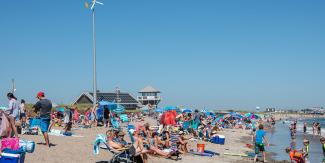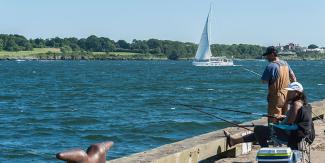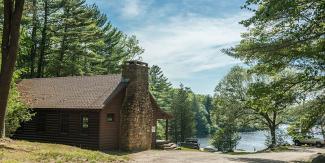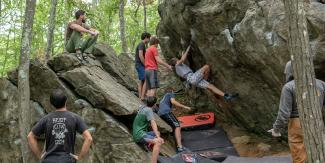RI State Parks Organizational Management and Operations Study
Final Report and Executive Summary
A Path forward to Sustaining and Strengthening Rhode Island's Historic Parks, Beaches, Bikeways, and Recreational Facilities
The DEM Division of Parks manages over 8,200 acres of land, including parks, beaches, campgrounds, bike paths, historic sites, picnic areas, trails, athletic fields, dams, fishing access, and boat ramps. This network attracts upwards of nine million visitors each year and hosts high-profile national and international events such as the Newport Jazz Festival, Newport Folk Festival, and Volvo Ocean Race. They also are an important contributor to the state’s economy and ability to attract new people and businesses to Rhode Island. Each year, our parks contribute an estimated $312 million of economic output and support over 3,700 jobs.
However, over the past 15 years, budget and staffing cuts, combined with heavy and increasing visitor use, aging facilities, and expanded responsibilities, threaten DEM’s ability to provide residents and visitors with well-maintained and accessible recreation facilities and opportunities. This study outlines key recommendations to ensure improved stewardship of Rhode Island State parks, beaches, and other recreational assets.

Invest in Operation & Staffing
Climate change, with warmer temperatures year-round, combined with increasing popularity of outdoor recreation, has extended the length of the outdoor season beyond the typical April to October timeframe. Parks employees take pride in welcoming visitors to clean, well-maintained facilities, but are hampered by low staffing levels, expanded responsibilities, an outdated organizational structure, and under-investment in customer-friendly technology and business tools. Investing in operations and staffing is critical to transforming the system into on that matches visitor expectations.
- INCREASE THE NUMBER OF MAINTENANCE TECHNICIANS to meet best practice standards and reduce major repairs and eliminate over-reliance on seasonal labor.
- ADD APPROPRIATELY SKILLED FULL-TIME EMPLOYEES TO REDUCE costly OUTSOURCING OF MAINTENANCE.
- PROVIDE SUPPORT STAFF TO RELIEVE MANAGERS OF ADMINISTRATIVE FUNCTIONS and increase their ability to appropriately supervise and support operational and maintenance functions.
- REALIGN THE DIVISION INTO FEWER REGIONS to facilitate a coordinated approach to park management, focus on functional requirements, minimize administrative responsibilities, and promote resource sharing of skilled staff and equipment.
- EXPAND DEM’S LEAN INITIATIVE to develop unified approaches in areas such as staff management, training, and recruitment.
- ESTABLISH BEST PRACTICE MAINTENANCE STANDARDS that align with each facility’s level of use and public profile and meet visitor expectations.
- EXPLORE AN INTEGRATED WORK ORDER MANAGEMENT SYSTEM to maximize the useful life of park assets and to minimize maintenance costs.

Increase the Financial Sustainability and Economic Potential of
State Parks
The outdoor recreation industry is thriving. According to the US Bureau of Economic Analysis, the United States gross domestic product (GDP) for 2018 shows the outdoor industry accounts for over 2% of the entire US GDP. The system plays an important role in Rhode Island’s outdoor recreation economy, and, with the right fiscal philosophies and practices, has the opportunity to capitalize on the growth of the industry.
- ESTABLISH A BUSINESS DEVELOPMENT OFFICE to concentrate on revenue generating strategies including cost accounting, sponsorship and donor development, grant opportunities, fees, concessions, leases, and fiscal entrepreneurship.
- ESTABLISH NEW PRICING AND FEE SETTING POLICIES for special events, site rentals, and special uses based on the market value, cost of service, and classification of the service.
- WORK WITH THE GENERAL ASSEMBLY AND THE OFFICE OF MANAGEMENT AND BUDGET TO DEVELOP A NEW BUDGET PROCESS that includes incentives to increase revenue, as well as a consistent capital funding level for facility and infrastructure needs.
- EVALUATE EXPANSION OF RECREATION AND BUSINESS OPPORTUNITIES WITHIN EACH PARK with a strategic program and business plan to increase revenue generation and visitor experiences as appropriate.

Protect State Park Assets and Infrastructure
Most private sector organizations and innovative public agencies follow a regular schedule of investment in facilities and infrastructure each year to optimize operating conditions and to keep the assets in good repair. It is critical to have consistent capital funds to properly maintain infrastructure (beyond general maintenance) to ensure that assets reach their anticipated lifecycles and protect critical State Park infrastructure and assets.
- WORK TO ENSURE A REGULAR AND CONSISTENT CAPITAL FUNDING STREAM to support State Parks’ deferred and capital asset needs.
- Use A PRIORITY SYSTEM TO REDUCE MAINTENANCE BACKLOGS by creating 5-year allocation plans.
- ADOPT DESIGN STANDARDS FOR THE ENTIRE PARK SYSTEM to minimize operations and maintenance costs after development.
- INCORPORATE CLIMATE CHANGE RESILIENCY STRATEGIES into facility design and development as recommended in 2018 Resilient Rhody Strategy.
- EXPLORE OPPORTUNITIES FOR PARTNERSHIPS to identify partnerships, concessions, and other opportunities to support State Park assets.
- USE LEAN, ESTABLISH STANDARDIZED PROTOCOLS to maintain facilities and systems such as opening and closing facilities, winterizing buildings, etc.






